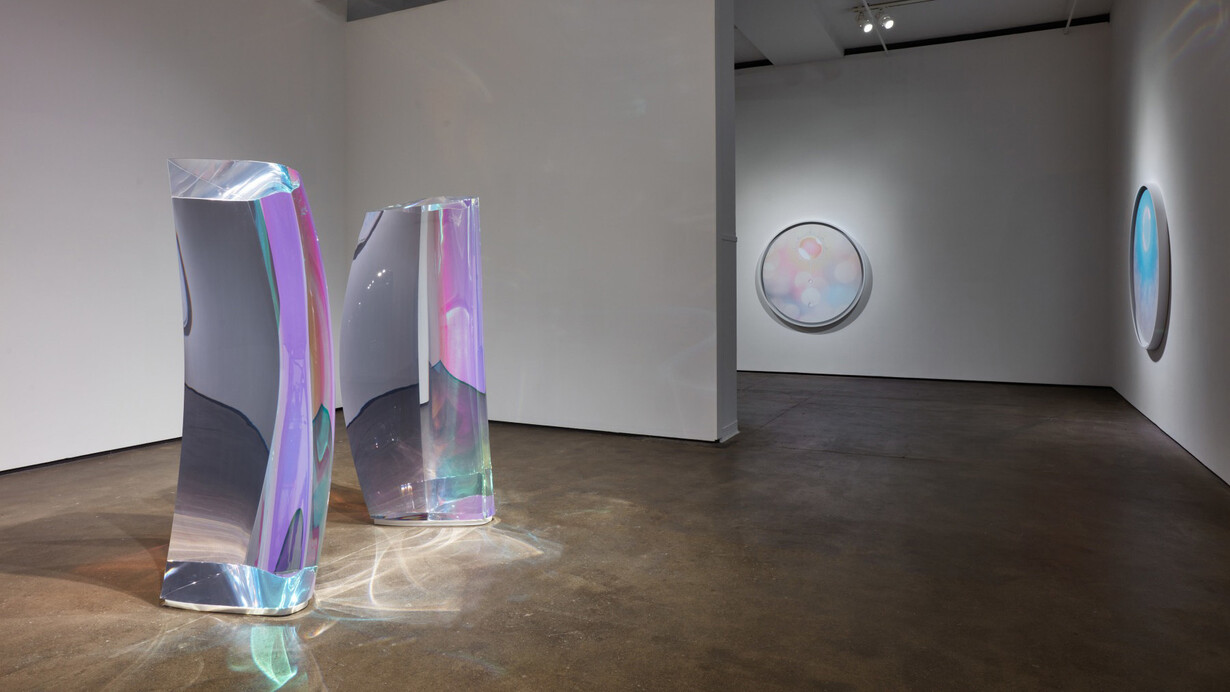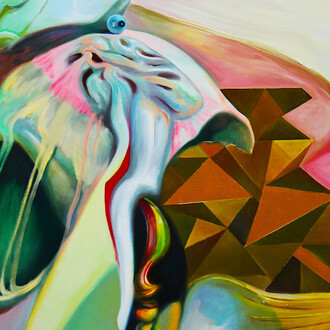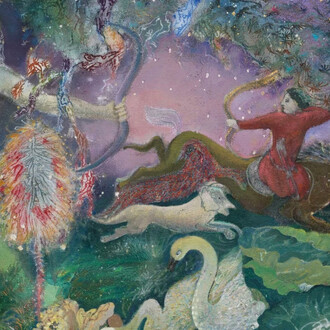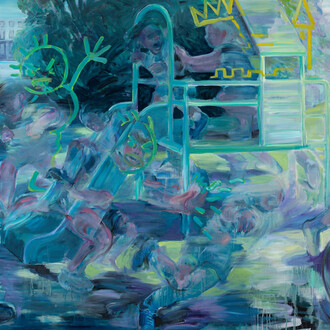Sean Kelly is delighted to present Radiance, an exhibition of new work by internationally acclaimed artist Mariko Mori. In this deeply contemplative presentation, Mori unites cutting-edge technological materials with ancient cosmologies, drawing inspiration from the enduring spiritual traditions of Japan. Spanning sculpture, installation, and works on paper, the exhibition reflects Mori’s long-standing engagement with metaphysical concepts and technical innovation grounded in her cultural heritage.
In the front gallery, Mori presents poetic works on silk and paper that extend the meditative quality of the series. Their refined execution and contemplative scale invite close looking, offering an intimate counterpart to the monumental stones and shrine. Together, these works create a rhythm of immersion and reflection that anchors the exhibition.
There’s an illusion of separation when it comes to physicality, but if you look beyond that, everything is connected.
(Mariko Mori)
Radiance is rooted in Mori’s extensive research into Japan’s stone cultures from the Jomon (14,000–300 BCE) and Yayoi (300 BCE–300 CE) periods through the Kofun (250–538 CE) and Asuka eras (538–710 CE). Informed by site visits to sacred geological formations across the Japanese archipelago, including the storied rocks of Okinoshima Island and the shrines of Izumo and Awaji, Mori focuses on these ancestral sites through a contemporary lens.
Upon entering the main gallery, visitors are greeted by two luminous stone pillars. These works, from Mori’s Stone series, reimagine Japan’s revered rocks, or Iwakura, which for millennia have been sites of divine presence. Their dichroic surfaces shift with ambient light and the viewer’s movement, reimagining invisible energies that recall the stones’ original function as portals to the sacred.
Mori’s Love sculpture is rooted in Japan’s earliest creation myths, drawing inspiration from the Kojiki, the oldest surviving creation text. In these legends, the first deities exist without gender or pairing—pure, singular forces of creation. Over time, gods began to appear as couples, culminating with Izanagi and Izanami, the divine pair who, according to legend, gave birth to the islands of Japan.
In her research across archaeological and sacred sites dating from the Kofun period (5th–7th centuries CE), Mori observed that many ancient iwakura, stones believed to be dwelling places or landing sites of spirits, appear in pairs. Sometimes joined, sometimes resting side by side, these “couple stones” were often understood as symbols of fertility and renewal. Their significance deepened during the Yayoi period, when the advent of rice cultivation brought heightened reverence for nature deities who governed rain and fertility, forces essential to communal survival and growth.
Mori’s Love reinterprets this symbolic pairing as a meditation on the essential bonds that sustain life. The title refers not only to romantic love, but also to the universal qualities of compassion, respect, and interconnection that bind all living beings to one another and to the natural world. Through the simplicity and enduring solidity of stone, Mori invites viewers to reflect on the act of coupling, between humans and as a fundamental principle of existence, a reminder that creation, harmony, and renewal arise through connection.
Artworks contain an intangible energy imbued within their materials—something unseen that resides within them. I have unwavering faith in this power and am committed to continuing my creative endeavors, trusting in the path that has naturally guided me.
(Mariko Mori)
Also in the main gallery, Mori has installed an environment that recreates the spiritual experience of entering shrines in Japan. Presented entirely in white, the installation evokes a space of purity and transcendence. A soft breeze gently moves through the silk veils wrapping the inner sanctum, infusing the work with an almost imperceptible sense of movement and breath.
Within this meditative environment are two additional stone works, Kamitate Stone I and Oshito Stone III, their luminous surfaces resonating with the surrounding architecture. Together, the shrine and sculptures form the heart of the exhibition, offering a space of stillness and reflection that connects historic belief systems with Mori’s futuristic vision.
The inner light that resides within the human soul radiates eternally, transcending life and death. Onogoro Stone stands as a symbol of this perpetual brilliance.
(Mariko Mori)
Surrounding this sacred core are Mori’s Unity photo paintings which reflect on the interconnectedness of all things. Rooted in rituals and philosophies such as the Chadō (tea ceremony), they embody Mori’s broader practice at the intersection of art, science, spirituality, and technology. As the artist recalls, the series was inspired by an overwhelming vision of radiant light.
Mori recalls, “the manifestation of a profound and boundless love—the primordial source from which all life arises… In that sacred moment, I felt a profound connection to the Great Light. My heart overflowed with the realization that no soul is ever truly alone.” Through these works, Mori conveys this eternal bond between the divine presence and all living beings.
To envision a world where everyone lives in peace — that very act of imagination is, I believe, the light that illuminates the path to our collective future.
(Mariko Mori)
Radiance expands Mori’s visionary practice, seamlessly intertwining the spiritual and the technological, the material and the immaterial. It invites viewers to journey through spaces of transcendence and reflection, reminding us of the interdependence of humanity, nature, and the cosmos.
















